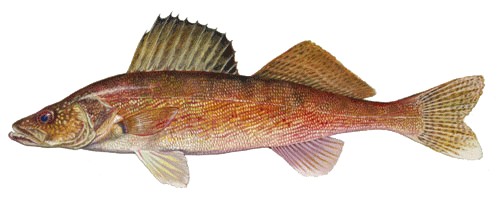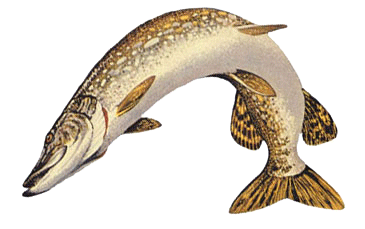
Additional Freshwater
Looking for more freshwater fish in Maryland? Check out some of the other great species found throughout our state.
Bluegill
 Members of the sunfish plan, Bluegills are olive green with some light yellow on their belly with dark bands running up and down. They have small mouths and an oval shaped body. Typically about 6 inches, they are found inshore from the Great Lakes to Florida—and here in Maryland in all tributaries of the Chesapeake Bay with salinity less than 18 ppt.
Members of the sunfish plan, Bluegills are olive green with some light yellow on their belly with dark bands running up and down. They have small mouths and an oval shaped body. Typically about 6 inches, they are found inshore from the Great Lakes to Florida—and here in Maryland in all tributaries of the Chesapeake Bay with salinity less than 18 ppt.
Freshwater fish, although they will venture into slightly salty water, blue gills like quiet waters such as lakes, ponds and slow flowing rivers and streams. Blue gills are easy and fun to catch making them ideal for young anglers. Earthworms or even corn kernels make good bait.
Longnose Gar
 A large, cylindrical fish with a long beak-like nose and rounded tail, their hard, diamond-shaped scales create a very effective armor against most predators. In fact their skin is so tough, that. reportedly, early settlers and native Americans used their hide as abrasives and shield covers. These typically gray to olive-colored fish reside are usually about 3-4 feet in length.
A large, cylindrical fish with a long beak-like nose and rounded tail, their hard, diamond-shaped scales create a very effective armor against most predators. In fact their skin is so tough, that. reportedly, early settlers and native Americans used their hide as abrasives and shield covers. These typically gray to olive-colored fish reside are usually about 3-4 feet in length.
They live in inshore waters and estuaries and in Maryland they inhabit the Chesapeake Bay’s tidal tributaries. Sight-fishing with a bow or speak is a coming method for capturing these tough fish. They can also be caught by suspending bait just below the surface of shallow areas or using frayed nylon cord as a lure. fishing methods
Walleye
 Named after its large opaque and almost blind-looking eye, dark or olive-green colored Walleye are common in most of Canada and the Northern U.S. The walleye is the largest member of the perch family, attaining lengths of more than 30 inches and weights of more than 10 pounds—and are considered to be one of the best-tasting freshwater fish.
Named after its large opaque and almost blind-looking eye, dark or olive-green colored Walleye are common in most of Canada and the Northern U.S. The walleye is the largest member of the perch family, attaining lengths of more than 30 inches and weights of more than 10 pounds—and are considered to be one of the best-tasting freshwater fish.
Walley prefer large, clear, cool bodies of water with gravel and sandy substrate. Fishing for walleye in the evening is most productive, using minnow type lures or jibs to fish near the bottom over rock piles or along the edge or weed beds. In Maryland, good walleye populations are found in Deep Creek Lake, Youghiogheny River Reservoir, Jennings Randolph Lake, Savage River Reservoir, Potomac River, and Liberty Reservoir. Efforts are currently underway to establish walleye populations in other Maryland reservoirs.
Northern Pike
 A highly prized gamefish, Northern Pike It is a fantastic fish to catch just based on its sheer size, strength, and fighting ability. Its bluish-green to gray color distinguishes from other members of the pike family. The northern pike is an elongated fish. Northern pike have an elongated body, fully scaled cheeks and a duck-bill shaped mouth lined with many sharp canine teeth. They are capable of growing more than three feet long and weighing greater than twenty pounds.
A highly prized gamefish, Northern Pike It is a fantastic fish to catch just based on its sheer size, strength, and fighting ability. Its bluish-green to gray color distinguishes from other members of the pike family. The northern pike is an elongated fish. Northern pike have an elongated body, fully scaled cheeks and a duck-bill shaped mouth lined with many sharp canine teeth. They are capable of growing more than three feet long and weighing greater than twenty pounds.
License and Regulations
Simple, quick, and at the palm of your hand, DNR’s app is the easiest way to get your Maryland fishing license. Download the app on your smartphone (MD DNR), click Apply for License, and enroll. From the app, you can also register any catches, post photos, and check for regulations updates. Or, you can apply for a license through Maryland Department of Natural Resources’ website. There are a few instances where registering for a license may not be necessary; visit Maryland DNR for a full list of these exceptions. For more information on fishing without a license – and locations where licenses are not required – visit http://dnr.maryland.gov/Fisheries/Pages/Free-Fishing.aspx. Visit the Maryland Department of Natural Resources for a complete list of Maryland’s Fishing Regulations.
Money generated from the sale of licenses goes directly to the conservation, protection, and preservation of Maryland’s natural habitat and cherished wildlife. Maryland DNR works tirelessly to maintain a healthy population of fish and game, and the regulations needed to sustain fishing and hunting in Maryland. Changes in regulations, dates, and requirements vary year-to-year. Please check with DNR frequently for the most up-to-date information.